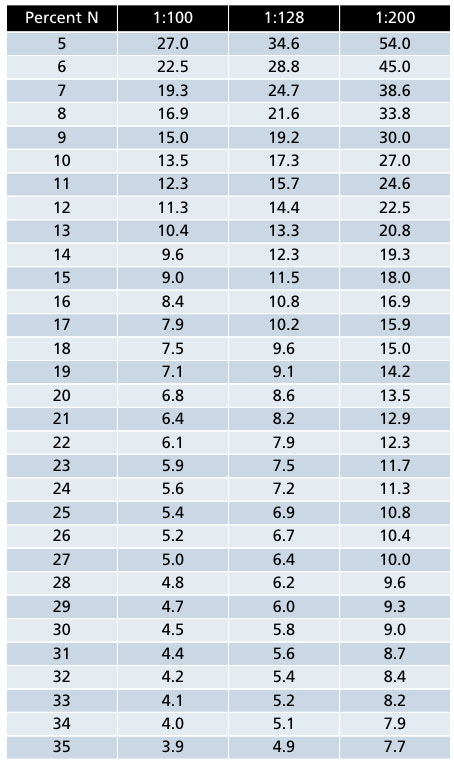6/1/2018
Your Secret Decoder Ring for Fertilizer Injectors
Rick Yates
Many of us have a love/hate relationship with technology. When we use our smartphones to find that BBQ restaurant everyone’s talking about, we feel pretty smug about our technological prowess. Later that same day, when our wireless printer would rather join our neighbor’s network than ours, that router’s blinking lights seem to mock our every move.
Some of us lump our fertilizer injectors in with the other technology in our lives that we try to keep at arm’s length. Does the phase “set it and forget it” hit a chord with you? Try to think of fertilizer injectors as workhorses waiting to be tamed. If ppm and injection ratios make you a little queasy, this article is for you.
Injection ratios vs. ppm
It’s a common misconception to think that the 1:100 or 1:200 markings on the outside of the fertilizer injector refer to how many parts per million of fertilizer the machine is set to deliver. These numbers are actually injection ratios.
Think of it this way: At a 1:100 ratio, 1 gal. of fertilizer concentrate will be injected into every 100 gal. of water that comes out of the hose. The ppm of the fertilizer solution produced depends on the injection ratio and the amount of fertilizer added to each gallon of concentrate.
For example, 200 ppm of 20-10-20 can be achieved by setting the injection ratio to 1:100 and then adding 13.5 oz. of fertilizer for every gallon of
concentrate.
As an example, calculations for a mobile Dosatron with a 12-gal. tank will look like this: 13.5 (oz.) x 12 (gal.) = 162 oz. or 10 lbs. of 20-10-20 to equal 200 ppm.
For a 15% nitrogen fertilizer such as 15-0-15 or 15-5-15, 18 oz. of fertilizer is required for each gallon of concentrate at a 1:100 injection ratio to yield 200 ppm.
(Head spinning? Would a chart help? Check out our easy-to-understand chart that accommodates all common fertilizer analysis and injection ratios.)
Changing ppm without turning your hands blue
Calculating for 200 ppm wasn’t so bad, but what if your vegetative petunias require more fertilizer than that? Mixing another batch of concentrate is an option, but if the injector is adjustable, that’s not necessary.
Dosatron injectors, for example, have externally adjustable ratio markings expressed as a percent: 0.2, 0.4 thru 2.0. Think of 1.0% as a 1:100 injection ratio and the starting point of your 200-ppm fertilizer solution from the example above. By adjusting the injector to 1.2%, you increase the ppm to 240 ppm (200 x 1.2), 1.4 yields 280 ppm and so on.
Increasing the ppm of fertilizer was easy, but what if you want to feed less than 200 ppm? Adjusting the percent to 0.6 lowers the ppm to 120 (200 x 0.6). From one concentrate solution, the ppm of fertilizer can be adjusted from 40 to 400, a wide enough spread to easily accommodate most crops.
Injecting chemigation-approved pesticides
Certain pesticides have chemigation labels, which allow them to be applied through injectors if the requirements spelled out on the label are met. By way of example, consider a product label that says you’re to inject a pesticide at a rate of 8 oz. per 100 gal. Earlier it was stated that at an injection ratio of 1:100 (1%) is the equivalent of taking 1 gal. of concentrate and injecting it into 100 gal. of water out the end of the hose. With 8 oz. per 100 gal. of final dilution, 8 oz. of pesticide mixed into 1 gal. of water is required for injection at a 1:100 ratio.
Always read and follow all pesticide label directions, including the chemigation section.
Calculate the amount of fertilizer required in ounces (by weight) to yield 100ppm N.
There are two variables:
1. The percentage of nitrogen (N) is derived from the fertilizer analysis (N-P-K). E.g., 15-5-25 is a 15% N fertilizer.
2. The injection ratio is determined by the injector and may either be a set ratio or adjustable depending on the make and model. E.g., 1:100 is a common injection ratio.

Example: Fertilize at 200 ppm of 20-10-20 through an injector set at a 1:100 injection ratio.
1. Select percentage of N from the column on the left side of the chart (20%).
2. Select the injection ratio from the top of the chart (1:100).
3. Where the columns intersect, find the number of ounces needed to provide 100 ppm N at the final dilution. (6.75 oz. by weight).
4. 200 ppm is the desired rate, multiply 6.75 oz. x 2= 13.5 oz. of 20-10-20 per gallon of concentrate to be injected at a 1:100 ratio. GT
Rick Yates is GGSPro Technical Support Manager for Griffin. He can be reached at ggsprotech@griffinmail.com.